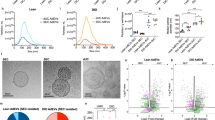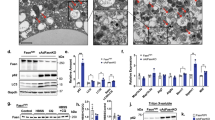Abstract
Background:
Fatty acid binding protein 4 (FABP4) is a predominantly cytosolic protein of the adipocytes, but also abundantly present in human plasma; its plasma concentrations were linked to obesity and metabolic syndrome. Recent studies have suggested a direct extracellular effect of FABP4 in the regulation of glucose metabolism and heart function independently of its effect as a carrier protein. Interestingly, FABP4 has no secretory signal sequence; hence, the mechanisms how FABP4 is released from adipocytes are unclear.
Methods and results:
In this study we investigated the mechanisms for FABP4 secretion from human adipocytes by using isolated primary pre-adipocytes (PAs) and the human adipocyte cell strain Simpson–Golabi–Behmel syndrome. In undifferentiated PAs, FABP4 expression was barely detectable and increased continuously during differentiation. The increase in FABP4 mRNA expression was accompanied by high levels of FABP4 secretion. In differentiated human adipocytes, FABP4 secretion was not abolished by blocking the Golgi-dependent secretory pathway in vitro, supporting a non-classical secretion mechanism for FABP4. However, raising intracellular Ca2+ levels enhanced FABP4 secretion in a concentration-dependent manner.
Conclusion:
This study shows that FABP4 is actively released from human adipocytes in vitro via a non-classical, calcium-dependent mechanism.
This is a preview of subscription content, access via your institution
Access options
Subscribe to this journal
Receive 12 print issues and online access
$259.00 per year
only $21.58 per issue
Buy this article
- Purchase on Springer Link
- Instant access to full article PDF
Prices may be subject to local taxes which are calculated during checkout





Similar content being viewed by others
References
Hertzel AV, Bernlohr DA . The mammalian fatty acid-binding protein multigene family: molecular and genetic insights into function. Trends Endocrinol Metab 2000; 11: 175–180.
Baxa CA, Sha RS, Buelt MK, Smith AJ, Matarese V, Chinander LL et al. Human adipocyte lipid-binding protein: purification of the protein and cloning of its complementary DNA. Biochemistry 1989; 28: 8683–8690.
Fu Y, Luo N, Lopes-Virella MF, Garvey WT . The adipocyte lipid binding protein (ALBP/aP2) gene facilitates foam cell formation in human THP-1 macrophages. Atherosclerosis 2002; 165: 259–269.
Elmasri H, Karaaslan C, Teper Y, Ghelfi E, Weng M, Ince TA et al. Fatty acid binding protein 4 is a target of VEGF and a regulator of cell proliferation in endothelial cells. FASEB J 2009; 23: 3865–3873.
Hotamisligil GS, Johnson RS, Distel RJ, Ellis R, Papaioannou VE, Spiegelman BM . Uncoupling of obesity from insulin resistance through a targeted mutation in aP2, the adipocyte fatty acid binding protein. Science 1996; 274: 1377–1379.
Uysal KT, Scheja L, Wiesbrock SM, Bonner-Weir S, Hotamisligil GS . Improved glucose and lipid metabolism in genetically obese mice lacking aP2. Endocrinology 2000; 141: 3388–3396.
Boord JB, Maeda K, Makowski L, Babaev VR, Fazio S, Linton MF et al. Adipocyte fatty acid-binding protein, aP2, alters late atherosclerotic lesion formation in severe hypercholesterolemia. Arterioscler Thromb Vasc Biol 2002; 22: 1686–1691.
Makowski L, Boord JB, Maeda K, Babaev VR, Uysal KT, Morgan MA et al. Lack of macrophage fatty-acid-binding protein aP2 protects mice deficient in apolipoprotein E against atherosclerosis. Nat Med 2001; 7: 699–705.
Furuhashi M, Hotamisligil GS . Fatty acid-binding proteins: role in metabolic diseases and potential as drug targets. Nat Rev Drug Discov 2008; 7: 489–503.
Lamounier-Zepter V, Look C, Alvarez J, Christ T, Ravens U, Schunck WH et al. Adipocyte fatty acid-binding protein suppresses cardiomyocyte contraction: a new link between obesity and heart disease. Circ Res 2009; 105: 326–334.
Xu A, Wang Y, Xu JY, Stejskal D, Tam S, Zhang J et al. Adipocyte fatty acid-binding protein is a plasma biomarker closely associated with obesity and metabolic syndrome. Clin Chem 2006; 52: 405–413.
Tonjes A, Kralisch S, Lossner U, Kovacs P, Bluher M, Stumvoll M et al. Metabolic and genetic predictors of circulating adipocyte fatty acid-binding protein. Int J Obes (Lond) 2012; 36: 766–773.
Wabitsch M, Brenner RE, Melzner I, Braun M, Moller P, Heinze E et al. Characterization of a human preadipocyte cell strain with high capacity for adipose differentiation. Int J Obes Relat Metab Disord 2001; 25: 8–15.
Klausner RD, Donaldson JG, Lippincott-Schwartz J, Brefeldin A . insights into the control of membrane traffic and organelle structure. J Cell Biol 1992; 116: 1071–1080.
Tartakoff A, Vassalli P, Detraz M . Comparative studies of intracellular transport of secretory proteins. J Cell Biol 1978; 79: 694–707.
Beeler TJ, Jona I, Martonosi A . The effect of ionomycin on calcium fluxes in sarcoplasmic reticulum vesicles and liposomes. J Biol Chem 1979; 254: 6229–6231.
Pressman BC, Fahim M . Pharmacology and toxicology of the monovalent carboxylic ionophores. Annu Rev Pharmacol Toxicol 1982; 22: 465–490.
Tuncman G, Erbay E, Hom X, De Vivo I, Campos H, Rimm EB et al. A genetic variant at the fatty acid-binding protein aP2 locus reduces the risk for hypertriglyceridemia, type 2 diabetes, and cardiovascular disease. Proc Natl Acad Sci USA 2006; 103: 6970–6975.
Cao H, Sekiya M, Ertunc ME, Burak MF, Mayers JR, White A et al. Adipocyte lipid chaperone AP2 is a secreted adipokine regulating hepatic glucose production. Cell Metab 2013; 17: 768–778.
Nickel W, Rabouille C . Mechanisms of regulated unconventional protein secretion. Nat Rev Mol Cell Biol 2009; 10: 148–155.
Ayers SD, Nedrow KL, Gillilan RE, Noy N . Continuous nucleocytoplasmic shuttling underlies transcriptional activation of PPARgamma by FABP4. Biochemistry 2007; 46: 6744–6752.
Gillilan RE, Ayers SD, Noy N . Structural basis for activation of fatty acid-binding protein 4. J Mol Biol 2007; 372: 1246–1260.
Xie L, Boyle D, Sanford D, Scherer PE, Pessin JE, Mora S . Intracellular trafficking and secretion of adiponectin is dependent on GGA-coated vesicles. J Biol Chem 2006; 281: 7253–7259.
Xie L, O'Reilly CP, Chapes SK, Mora S . Adiponectin and leptin are secreted through distinct trafficking pathways in adipocytes. Biochim Biophys Acta 2008; 1782: 99–108.
Makowski L, Hotamisligil GS . The role of fatty acid binding proteins in metabolic syndrome and atherosclerosis. Curr Opin Lipidol 2005; 16: 543–548.
Furuhashi M, Fucho R, Gorgun CZ, Tuncman G, Cao H, Hotamisligil GS . Adipocyte/macrophage fatty acid-binding proteins contribute to metabolic deterioration through actions in both macrophages and adipocytes in mice. J Clin Invest 2008; 118: 2640–2650.
Boord JB, Maeda K, Makowski L, Babaev VR, Fazio S, Linton MF et al. Combined adipocyte-macrophage fatty acid-binding protein deficiency improves metabolism, atherosclerosis, and survival in apolipoprotein E-deficient mice. Circulation 2004; 110: 1492–1498.
Lamounier-Zepter V, Ehrhart-Bornstein M, Karczewski P, Haase H, Bornstein SR, Morano I . Human adipocytes attenuate cardiomyocyte contraction: characterization of an adipocyte-derived negative inotropic activity. FASEB J 2006; 20: 1653–1659.
Look C, Morano I, Ehrhart-Bornstein M, Bornstein SR, Lamounier-Zepter V . Adipocyte-derived factors suppress heart contraction. Int J Obes (Lond) 2011; 35: 84–90.
Engeli S, Utz W, Haufe S, Lamounier-Zepter V, Pofahl M, Traber J et al. Fatty acid binding protein 4 predicts left ventricular mass and longitudinal function in overweight and obese women. Heart 2013; 99: 944–948.
Lehmann F, Haile S, Axen E, Medina C, Uppenberg J, Svensson S et al. Discovery of inhibitors of human adipocyte fatty acid-binding protein, a potential type 2 diabetes target. Bioorg Med Chem Lett 2004; 14: 4445–4448.
Ringom R, Axen E, Uppenberg J, Lundback T, Rondahl L, Barf T . Substituted benzylamino-6-(trifluoromethyl)pyrimidin-4(1H)-ones: a novel class of selective human A-FABP inhibitors. Bioorg Med Chem Lett 2004; 14: 4449–4452.
Furuhashi M, Tuncman G, Gorgun CZ, Makowski L, Atsumi G, Vaillancourt E et al. Treatment of diabetes and atherosclerosis by inhibiting fatty-acid-binding protein aP2. Nature 2007; 447: 959–965.
Look C, Morano I, Ehrhart-Bornstein M, Bornstein SR, Lamounier-Zepter V . BMS309403 directly suppresses cardiac contractile function. Naunyn Schmiedebergs Arch Pharmacol 2011; 384: 255–263.
Kralisch S, Ebert T, Lossner U, Jessnitzer B, Stumvoll M, Fasshauer M . Adipocyte fatty acid-binding protein is released from adipocytes by a non-conventional mechanism. Int J Obes (Lond) 2014 doi:10.1038/ijo.2013.232.
Acknowledgements
We gratefully acknowledge the excellent technical support of Uta Lehnert. We thank Dr med. Holger Pult for the help in obtaining human adipose tissue. Furthermore, we thank Kathleen Eisenhofer for proofreading this paper. This study was supported by the German Competence Network for Obesity (‘Kompetenznetz Adipositas’) and funded by the Federal Ministry of Education and Research (Central and Peripheral Mechanisms of Obesity, Grant 01GI1122G to VLZ).
Author information
Authors and Affiliations
Corresponding author
Ethics declarations
Competing interests
The authors declare no conflict of interest.
Rights and permissions
About this article
Cite this article
Schlottmann, I., Ehrhart-Bornstein, M., Wabitsch, M. et al. Calcium-dependent release of adipocyte fatty acid binding protein from human adipocytes. Int J Obes 38, 1221–1227 (2014). https://doi.org/10.1038/ijo.2013.241
Received:
Revised:
Accepted:
Published:
Issue Date:
DOI: https://doi.org/10.1038/ijo.2013.241
Keywords
This article is cited by
-
p21-activated kinase 4 counteracts PKA-dependent lipolysis by phosphorylating FABP4 and HSL
Nature Metabolism (2024)
-
A hormone complex of FABP4 and nucleoside kinases regulates islet function
Nature (2021)
-
Differentiating SGBS adipocytes respond to PPARγ stimulation, irisin and BMP7 by functional browning and beige characteristics
Scientific Reports (2019)
-
Role of bone marrow adipocytes in leukemia and chemotherapy challenges
Cellular and Molecular Life Sciences (2019)
-
Circulating FABP4 is eliminated by the kidney via glomerular filtration followed by megalin-mediated reabsorption
Scientific Reports (2018)



